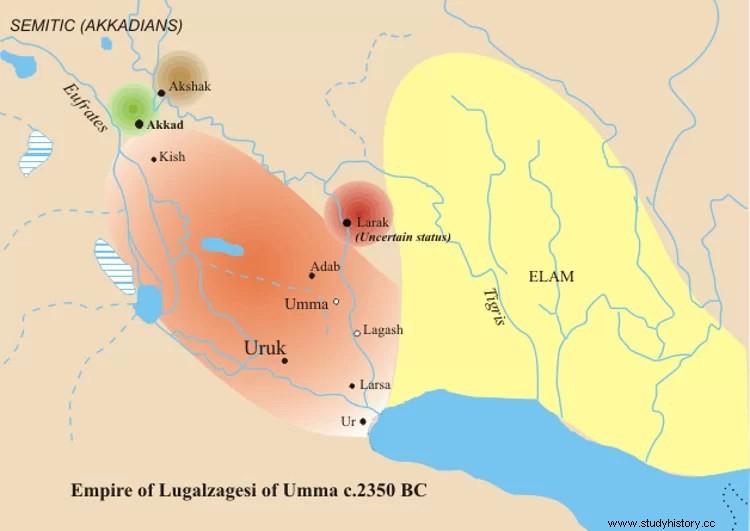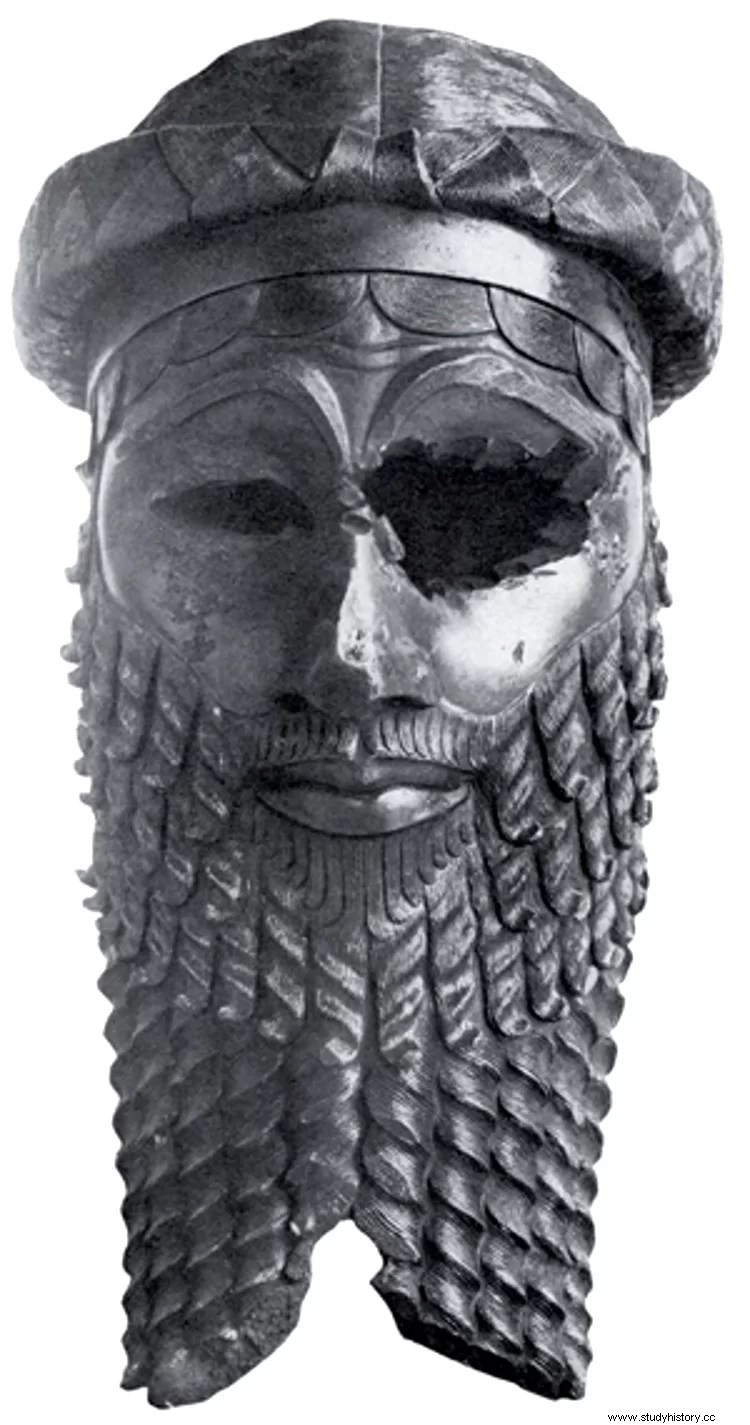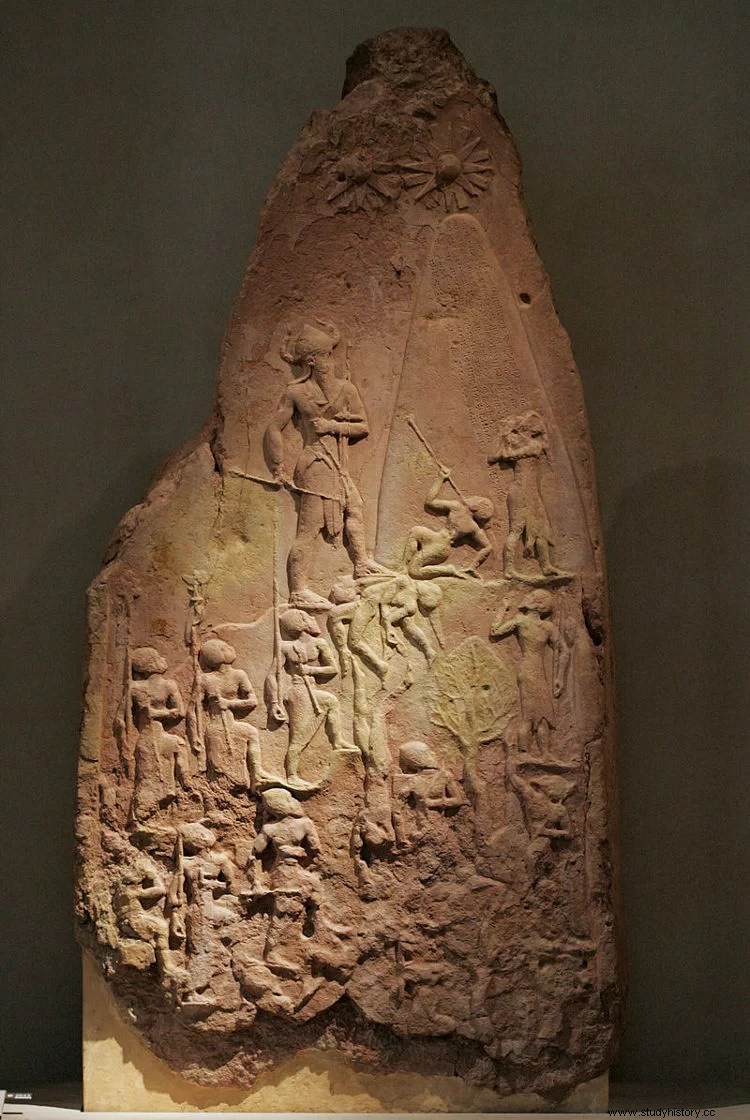"My mother was a high priestess, I did not know my father." With this famous phrase, a rare combination of pride and modesty (and which is actually many centuries later), the founder of a new dynasty in the Mesopotamian kingdom of Acad and creator of what can be considered the first great empire of Antiquity, since it was four times the size of its neighbor, the Ancient Egyptian Empire. He was called Sargon I the Great .
Acad was a city located on the western bank of the Euphrates, a river that rises in the Anatolian mountains of present-day Turkey and flows for 2,780 kilometers towards the Persian Gulf, confluence with the Tigris to form what is now known as the Shatt al -Arab and that three millennia ago irrigated a region called Mesopotamia (whose literal meaning is between two rivers ).
Thanks to these waters, it was so rich that, because it extended in the shape of a crescent from the aforementioned gulf to the Nile delta and its course through Upper Egypt, it received the name of the Fertile Crescent.

The first historical civilizations were born there -in parallel to others such as the American ones of Caral and Tres Zapotes, plus the early pre-classic Maya, and the Chinese of the Xia dynasty-. There, the passage from Prehistory (Neolithic) to History took place when writing was developed around the year 3,000 BC. And there the first city-states that constituted the Sumerian civilization appeared:Lagash, Uruk, Ur, Umma, Eridu... It was the predominant one until around 2300 B.C. a character was born who was going to change the panorama.
Not much is known of Sargon's origins. As we said at the beginning, a legend written down by the Neo-Assyrians in the 7th century B.C. identified him as the son of a nomad and a priestess, who abandoned him in a river in a basket, being found and adopted by a peasant. It is a leiv motiv that would be repeated a thousand times, from Moses to Romulus and Remus, but it provides the fact that his progenitor was originally from Azupiranu, a city located "on the banks of the Euphrates" , which gives Sargon a Semitic character.

Although the Semites could not be considered an ethnic group, it is believed that there were many semi-nomads from the Arabian desert who settled in the region, especially in the city of Kish. Despite this origin, Sargon progressed in some way -according to a legend, through the mediation of the goddess Inanna while he was still a gardener- until he became chief cupbearer of King Urzababa; This is indicated by the Royal List, a tablet that lists the rulers of Sumer. While in that position, he confided in the sovereign a dream he had had, in which he drowned him in a river of blood on Inanna's instructions. As you can imagine, Urzababa was not amused.
Consequently he decided to get rid of him, first by ordering his blacksmith to kill him, and then, having been prevented by Inanna, sending him to Lugalzagesi, king of Umma and Uruk, as a courier. The tablet that Sargón had to give to the sovereign was not but the request that he finish with the messenger. The fragments that told what happened have been lost, but evidently Sargon was not only able to escape but became monarch.
Probably everything is a poetic way of explaining a coup d'état, perhaps taking advantage of a military defeat by Urzababa that left Kish in ruins at the mercy of whoever knew how to take advantage of the occasion. At the end of the day, it is another story that will also be repeated; remember the biblical stories of Joseph, Bellerophon and Uriah.

Owner, then, of a battered Kish, Sargon founded a new city to the north which he called Acad, surely to give primacy to those Semitic immigrants who had been gradually settling in Sumer along with other groups such as the Amorites. Today the exact location of the city is unknown, although it is believed to be on the outskirts of present-day Baghdad.
But it was not enough for Sargon and in the middle of the 24th century B.C. he launched into a military expansion whose first victim was Lugalzagesi's Uruk; he defeated him after three battles, later forcing him to walk to the temple of Enlil (located in Nippur) with a ring around his neck as proof that the gods supported the victor.

He then continued his campaign, subduing one after another the other Sumerian cities, paradoxically weakened earlier by Lugalzagesi. Thus fell Ur, Lagash and Umma, ensuring control of all of Lower Mesopotamia to set their following objectives:Elam (in present-day Iran), Mari and Ebla (in Syria), reaching what is now the coast of Lebanon and the south of Cappadocia. It is not surprising that Sargon defined himself as "he who has traversed the Four Zones" , Akkadian expression to designate the universe. According to the Nippur Inscription (a Babylonian tablet found in 1890), his titles were "king of Acad, overseer of Inanna, king of Kish, anointed of Anu, king of Earth [Mesopotamia], ruler of Enlil".

Thirty-four cities came under his rule, ruling for fifty-six years. They were not peaceful, as the subjugated peoples often rebelled and even besieged Acad, although in the end they were defeated. It was an unprecedented panorama until then, since it was the first time that a territory was configured based on localities united under the same crown that had absolute power, instead of the usual city-states, and watched over by a permanent army. However, management was left in the hands of local magistrates who were accountable to anensi or governor.
Governing that entity required the introduction of novelties, such as a hierarchical administrative network:governors, civil and military officials, scribes, accountants, inspectors, etc. The king had the delegated services of " five thousand four hundred men sitting at his table" . He was remunerated with movable and immovable property, which brought about a redistribution of wealth and the creation of classes based on their economic possibilities. In this way, the greatest "capitalist" was no longer the state or the city but the monarch himself, followed by his assistants.
On the other hand, Sargon opened a process of Semitization, substituting the Sumerian language for Akkadian in the documents (in speech the former was allowed to endure, although in practice it tended to be subordinated and would end up disappearing), although it was adopted cuneiform writing.
Likewise, the pantheon was syncretized and, for example, Inanna, the great supporter of the king, became Ishtar. This religious revolution extended to the arts, with the substitution of Sumerian aesthetic hieraticism for a more vivid and realistic iconography. It was, in short, a period of splendor and Acad a commercial hub by land and sea.

Sargon had a wife named Tashlultum, of whom we know nothing more than that she bore him five children. Her firstborn was the priestess-poetess Enheduanna, to whom we have already dedicated an article; the others were called Rimush, Manishtushu, Shu-Enlil, and Ilaba'is-Takal. The first inherited the throne when his father died around 2215 BC. and he had to face insurrection attempts that ended with the independence of Ebla. He reigned nine years and died in a palace revolt, being succeeded by his brother Manishtushu, who found himself in an equally unstable situation with the addition of the appearance of an external danger:the Hurrians.
He too was the victim of a crime, so the crown fell to his son Naramsin, who reigned thirty-six years or so. With him at the helm, the Akkadian empire experienced its last great period, which is why its holder deified himself by calling himself King of the Four Zones and King of the Universe.
His death around 2198 B.C. brought anarchy and civil war, legendarily explained by his blasphemous audacity to plunder the sanctuary of Enlil, in Nippur, but in reality duly cheered on by another foreign people, from the east of Tigris:the Guti, who in a few years, after the definitive collapse of the Akkadian empire, they would take over Mesopotamia for a century.
